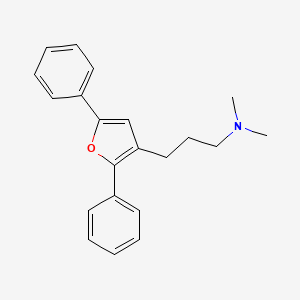|
Name: Phenampromide
Type: Opioid
AKA: N/A

|
|
II. Natural Derivative
Synthetic substance, no natural derivative
 |
|
III. Chemical Profile (IUPAC name)

|
|
IV. History
Phenampromide is a synthetic opioid analgesic developed in the mid-20th century. It is a derivative of isomethadone and has been studied for its analgesic properties. Phenampromide is not widely used in clinical practice but remains of interest in the study of opioid pharmacology and the development of new analgesics.

|
|
V. Legal Information
Phenampromide, a synthetic opioid, is controlled as a substance with potential for abuse. In the US, it may be regulated under general opioid laws. Globally, its legal status reflects increasing restrictions on synthetic opioids to address public health concerns related to addiction and misuse.
US Federal Schedule - I
Schedule I drugs, substances, or chemicals are defined as drugs with no currently accepted medical use and a high potential for abuse. Some examples of Schedule I drugs are: heroin, lysergic acid diethylamide (LSD), marijuana (cannabis), 3,4-methylenedioxymethamphetamine (ecstasy), methaqualone, and peyote.
Key US Federal Policies:
Controlled Substances Act. Public Law: Public Law 91-513 (text can be found on GovInfo) (https://www.dea.gov/drug-information/csa). Date enacted: October 27, 1970.
|
|
VI. Physical Effects
Phenampromide, an opioid, is used for pain relief. As a downer, it provides significant sedation and respiratory depression. Short-term effects include pain relief and euphoria, while long-term use can lead to addiction and tolerance. Overdose risks include severe respiratory depression and potential death. Safe dosing requires careful monitoring. Recent findings focus on its efficacy for severe pain and the potential for misuse and addiction.  |
|
VII. Psychological Effects
Phenampromide, an opioid derivative, affects opioid receptors to provide pain relief and euphoria. Psychological effects include mood alteration and cognitive impairment. Immediate effects last several hours, while long-term use can lead to dependence and severe mental health issues. Research focuses on its safety profile, efficacy, and potential for abuse compared to other opioids.
 |
|
VIII. Culture
Phenampromide is an opioid analgesic with no historical or cultural lore, emerging in the 20th century. Its significance lies in its role in pain management and the opioid crisis. Proponents emphasize its effectiveness for pain relief, while opponents highlight risks of dependence and misuse. Its use is primarily medicinal, reflecting ongoing debates about opioid regulation and public health.
 |
